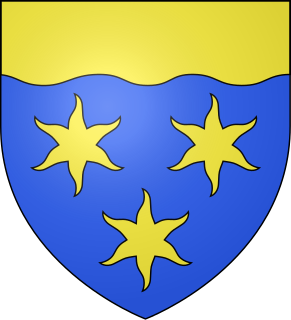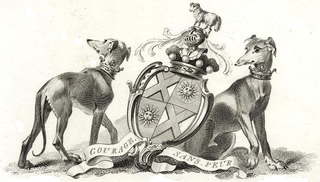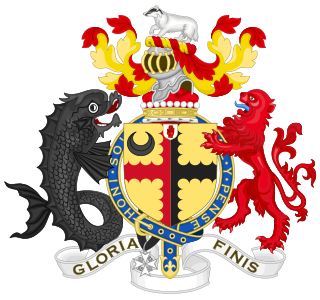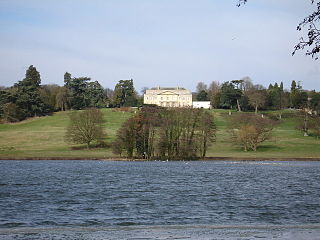
Earl of Galloway is a title in the Peerage of Scotland. It was created in 1623 for Alexander Stewart, 1st Lord Garlies, with remainder to his heirs male bearing the name and arms of Stewart. He had already been created Lord Garlies in the Peerage of Scotland in 1607, with remainder to the heirs male of his body succeeding to the estates of Garlies. This branch of the Stewart family were distant relatives of the Stewart Kings of Scotland.

Earl of Radnor is a title which has been created twice. It was first created in the Peerage of England in 1679 for John Robartes, 2nd Baron Robartes, a notable political figure of the reign of Charles II. He was made Viscount Bodmin at the same time. Robartes was the son of Richard Robartes, who had been created Baronet in July 1621 and Baron Robartes, of Truro, in the Peerage of England in 1626. All three titles became extinct on the death of the fourth Earl in 1757. Anna Maria Hunt, great-niece of the fourth Earl, married the Hon. Charles Bagenal-Agar, youngest son of James Agar, 1st Viscount Clifden of Gowran. Their son Thomas James Agar-Robartes was created Baron Robartes in 1869. For more information on this title, see the Viscount Clifden.

Earl Talbot is a title that has been created twice in the Peerage of Great Britain. This branch of the Talbot family descends from the Hon. Sir Gilbert Talbot, third son of John Talbot, 2nd Earl of Shrewsbury. His great-great-great-grandson, the Right Reverend William Talbot, was Bishop of Oxford, of Salisbury and of Durham. His eldest son Charles Talbot was a prominent lawyer and politician. In 1733, he was raised to the Peerage of Great Britain as Lord Talbot, Baron of Hensol, in the County of Glamorgan, and then served as Lord High Chancellor of Great Britain from 1733 to 1737.

Earl of Egmont was a title in the Peerage of Ireland, created in 1733 for John Perceval, 1st Viscount Perceval. It became extinct with the death of the twelfth earl in 2011.

Earl of Onslow, of Onslow in the County of Shropshire and of Clandon Park in the County of Surrey is a title in the Peerage of the United Kingdom. It was created in 1801 for George Onslow, 4th Baron Onslow.

Earl of Chichester is a title that has been created three times, twice in the Peerage of England and once in the Peerage of the United Kingdom. The current title was created in the Peerage of the United Kingdom in 1801 for Thomas Pelham, 2nd Baron Pelham of Stanmer.

Earl of Lonsdale is a title that has been created twice in British history, firstly in the Peerage of Great Britain in 1784, and then in the Peerage of the United Kingdom in 1807, both times for members of the Lowther family.

Earl Howe is a title that has been created twice in British history, for members of the Howe and Curzon-Howe family respectively. The first creation, in the Peerage of Great Britain, was in 1788 for Richard Howe, but became extinct on his death in 1799. The second creation, in the Peerage of the United Kingdom was in 1821 for Richard Curzon, and remains extant.

Viscount Gage, of Castle Island in the County of Kerry of the Kingdom of Ireland, is a title in the Peerage of Ireland. It was created in 1720 for Thomas Gage, along with the subsidiary title of Baron Gage, of Castlebar in the County of Mayo, also in the Peerage of Ireland. In 1744 he also succeeded his cousin as eighth Baronet, of Firle Place. The titles remain united. The Gage family descends from John Gage, who was created a baronet, of Firle Place in the County of Sussex, in the Baronetage of England on 26 March 1622. His great-grandson, the seventh Baronet, represented Seaford in Parliament. He was succeeded by his first cousin, Thomas Gage, 1st Viscount Gage, the eighth Baronet. He sat as a Member of Parliament for Minehead and Tewkesbury and also served as Governor of Barbados. In 1720, 24 years before succeeding in the baronetcy, he was raised to the Peerage of Ireland as Baron Gage and Viscount Gage. His second son was the military commander the Hon. Thomas Gage.

Viscount Brookeborough, of Colebrooke in the County of Fermanagh, is a title in the Peerage of the United Kingdom. It was created in 1952 for the Ulster Unionist politician and Prime Minister of Northern Ireland, Captain The Rt. Hon. Sir Basil Brooke, 5th Bt., P.C. (N.I.), M.P.

Viscount Scarsdale, of Scarsdale in Derbyshire, is a title in the Peerage of the United Kingdom. It was created in 1911 for the prominent Conservative politician and former Viceroy of India George Curzon, 1st Baron Curzon of Kedleston, who was created Earl Curzon of Kedleston at the same time and was later made Marquess Curzon of Kedleston.
Baron Joicey, of Chester-le-Street in the County of Durham, is a title in the Peerage of the United Kingdom. It was created in 1906 for the coal mining magnate and former Liberal Member of Parliament for Chester-le-Street, Sir James Joicey, 1st Baronet. He had already been created a baronet, of Longhirst and of Ulgham, both in the County of Northumberland, in the Baronetage of the United Kingdom in 1893. He was succeeded by his eldest son, the second Baron. He was High Sheriff of County Durham in 1910. The second baron lost his son young, and on his death his younger brother succeeded to the barony. The third Baron was an army officer, whose elder son died in WWII without male issue, and he was thus succeeded by his younger son, the fourth baron. As of 2010 the titles are held by the latter's eldest son, the fifth Baron, who succeeded in 1993.
Baron Wolverton, of Wolverton in the County of Buckingham, is a title in the Peerage of the United Kingdom. It was created in 1869 for the banker George Glyn. He was the fourth son of Sir Richard Carr Glyn, 1st Baronet, of Gaunt's House, Lord Mayor of London in 1798, himself the fourth son of Sir Richard Glyn, 1st Baronet, of Ewell, Lord Mayor of London in 1758. Lord Wolverton was succeeded by the eldest of his nine sons, the second Baron. He was a Liberal politician and served under William Ewart Gladstone as Paymaster-General and as Postmaster General. He was childless and was succeeded by his nephew, the third Baron. He was the eldest son of Vice-Admiral the Hon. Henry Carr Glyn, younger son of the first Baron. He died childless the following year aged only twenty-six, and was succeeded by his younger brother, the fourth Baron. He served as Vice-Chamberlain of the Household from 1902 to 1905 in the Conservative administration of Arthur Balfour. On the death in 1988 of his second but eldest surviving son, the fifth Baron, this line of the family failed. The title was inherited by the late Baron's second cousin, the sixth Baron. He was the grandson of the Hon. Pascoe Glyn, younger son of the first Baron. As of 2011 the title is held by his grandson, the eighth Baron, who succeeded in 2011.
Baron Mostyn, of Mostyn in the County of Flint, is a title in the Peerage of the United Kingdom. It was created in 1831 for Sir Edward Lloyd, 2nd Baronet, who had earlier represented Flint Boroughs and Beaumaris in the House of Commons. His son, the second Baron, sat as a Member of Parliament for Flintshire and Lichfield and served as Lord Lieutenant of Merionethshire.

There have been three baronetcies created for members of the Blakiston family of Blakiston, County Durham, two in the Baronetage of England and one in the Baronetage of Great Britain. One creation is extant as of 2008.

Sir Thomas Edward Colebrooke, 4th Baronet, who was known as Sir Edward Colebrooke, was a British politician.
Edward Arthur Colebrooke, 1st Baron Colebrooke,, known as Sir Edward Colebrooke, Bt, from 1890 to 1906, was a British Liberal politician and courtier. He served as Captain of the Honourable Corps of Gentlemen-at-Arms under H. H. Asquith and David Lloyd George between 1911 and 1922.

Sir James Edward Colebrooke, 1st Baronet sat in the House of Commons from 1751 to 1761.
Sir George Colebrooke, 2nd Baronet, of Gatton in Surrey, was an English merchant banker, chairman of the East India Company and Member of Parliament, who bankrupted himself through unwise speculations.

Earl of Arran is a title in the Peerage of Ireland. It is not to be confused with the title Earl of Arran in the Peerage of Scotland. The two titles refer to different places: the Aran Islands in Ireland, and the Isle of Arran in Scotland. The Irish earldom is held by the Gore family. The Scottish earldom is a separate title, held as a subsidiary title of the Duke of Hamilton.









